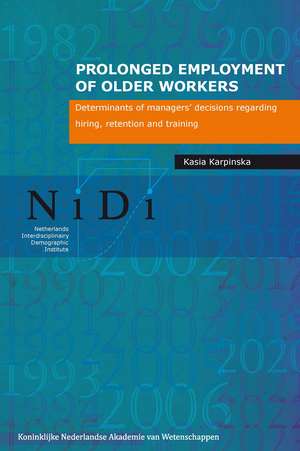Prolonged Employment of Older Workers: Determinants of Managers’ Decisions Regarding Hiring, Retention and Training: NiDi Boek
Autor Kasia Karpinskaen Limba Engleză Paperback – 27 feb 2013
As populations age in countries across the world, the maintenance of welfare and social security systems will depend on the prolonged, productive employment of older workers. However, not much is known about the factors that determine whether—and how—older adults work. With Prolonged Employment of Older Workers, Kasia Karpinska helps fill in the gap. This timely study explores the managerial attitudes and worker characteristics that influence managers’ decisions to hire, train, and retain older employees. In the process, it suggests possible solutions to a problem that weighs heavily on many nations.
Preț: 225.99 lei
Preț vechi: 286.84 lei
-21% Nou
Puncte Express: 339
Preț estimativ în valută:
43.26€ • 47.00$ • 36.36£
43.26€ • 47.00$ • 36.36£
Carte indisponibilă temporar
Doresc să fiu notificat când acest titlu va fi disponibil:
Se trimite...
Preluare comenzi: 021 569.72.76
Specificații
ISBN-13: 9789069846668
ISBN-10: 9069846667
Pagini: 144
Dimensiuni: 152 x 229 x 8 mm
Greutate: 0.3 kg
Editura: Amsterdam University Press
Colecția Amsterdam University Press
Seria NiDi Boek
ISBN-10: 9069846667
Pagini: 144
Dimensiuni: 152 x 229 x 8 mm
Greutate: 0.3 kg
Editura: Amsterdam University Press
Colecția Amsterdam University Press
Seria NiDi Boek
Notă biografică
Kasia Karpinska is a postdoctoral researcher at Erasmus University Rotterdam in the Netherlands.
Cuprins
1.1. Introduction
1.2. Ageing and labour market participation in the Netherlands........ 11
1.3. Previous research on older workers’ employment........................ 19
1.4. Theoretical perspectives................................................................ 21
2. The recruitment of early retirees: a vignette study of the factors that affect managers’ decisions
2.1. Introduction................................................................................... 27
2.2. The determinants of hiring desirability......................................... 30
2.3. Methods......................................................................................... 32
2.4. The findings................................................................................... 36
2.4.1. Hiring desirability.............................................................. 39
2.5. Discussion and conclusions.......................................................... 40
3. Hiring retirees. Impact of age norms and stereotypes
3.1. Introduction................................................................................... 45
3.2. Theory............................................................................................ 47
3.3. Data and methods.......................................................................... 52
3.4. Results........................................................................................... 58
3.5. Illustration of the effects of age norms......................................... 61
3.6. Discussion and conclusions.......................................................... 64
4. Retention of older workers: impact of manager’s age norms and stereotypes
4.1. Introduction................................................................................... 69
4.2. Theoretical background................................................................. 71
4.2.2. Attributes of employees..................................................... 72
4.3. Data and methods ......................................................................... 76
4.4. Results........................................................................................... 83
4.5. Discussion and conclusions.......................................................... 89
5. Training opportunities for older workers in the Netherlands
A policy capturing study........................................................................ 93
5.1. Introduction................................................................................... 93
5.2. Theoretical background................................................................. 96
5.3. Data and methods........................................................................ 100
5.4. Results......................................................................................... 105
5.5. Discussion and conclusions........................................................ 107
6. Conclusion
6.1. Background and the aim of the study......................................... 113
6.2. Summary of the results and conclusions from the
empirical chapters....................................................................... 114
6.3. Discussion and scientific relevance............................................ 121
6.4. Methodological considerations................................................... 125
6.5. Concluding remarks.................................................................... 127
1.2. Ageing and labour market participation in the Netherlands........ 11
1.3. Previous research on older workers’ employment........................ 19
1.4. Theoretical perspectives................................................................ 21
2. The recruitment of early retirees: a vignette study of the factors that affect managers’ decisions
2.1. Introduction................................................................................... 27
2.2. The determinants of hiring desirability......................................... 30
2.3. Methods......................................................................................... 32
2.4. The findings................................................................................... 36
2.4.1. Hiring desirability.............................................................. 39
2.5. Discussion and conclusions.......................................................... 40
3. Hiring retirees. Impact of age norms and stereotypes
3.1. Introduction................................................................................... 45
3.2. Theory............................................................................................ 47
3.3. Data and methods.......................................................................... 52
3.4. Results........................................................................................... 58
3.5. Illustration of the effects of age norms......................................... 61
3.6. Discussion and conclusions.......................................................... 64
4. Retention of older workers: impact of manager’s age norms and stereotypes
4.1. Introduction................................................................................... 69
4.2. Theoretical background................................................................. 71
4.2.2. Attributes of employees..................................................... 72
4.3. Data and methods ......................................................................... 76
4.4. Results........................................................................................... 83
4.5. Discussion and conclusions.......................................................... 89
5. Training opportunities for older workers in the Netherlands
A policy capturing study........................................................................ 93
5.1. Introduction................................................................................... 93
5.2. Theoretical background................................................................. 96
5.3. Data and methods........................................................................ 100
5.4. Results......................................................................................... 105
5.5. Discussion and conclusions........................................................ 107
6. Conclusion
6.1. Background and the aim of the study......................................... 113
6.2. Summary of the results and conclusions from the
empirical chapters....................................................................... 114
6.3. Discussion and scientific relevance............................................ 121
6.4. Methodological considerations................................................... 125
6.5. Concluding remarks.................................................................... 127
